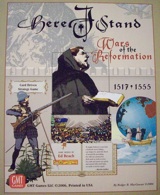Here I Stand – Boardgame Review
 Here I Stand
Here I Stand
By GMT Games
Designed by Ed Beach
$79.00 MSRP
Passed Inspection: Excellent multiplayer game combining military strategy with diplomacy and resource management.
Failed Basic: Expect one game of Here I Stand to last an entire day.
Occasionally Protestant debaters may be put to the torch.
Europe in the 1500s was not a pleasant place to live. Near-constant warfare among the various nations over lands, alliances and religious affiliation made it a chaotic, terrible age. This same chaos makes for an excellent wargame, however, and Here I Stand combines standard wargaming with diplomatic overtures and clandestine deals. The primary event of this era was the Reformation, pitting Catholic against Protestant for the right to claim the One True Faith, and this conflict adds significant spice to the game.
{default}Players begin the game having selected one of the six major powers available — the Hapsburgs, France, the Papacy, Protestant, Ottoman and England — and play begins with the mandatory event of Luther’s 95 theses, which gives the Protestant player a chance to control cities in the German regions of the Holy Roman Empire. Control gives bonus to sway nearby cities subsequently, and so the region is ripe to be plucked by a shrewd Protestant player. The Papacy and the Holy Roman Emperor are not without means to combat this perceived treachery, however; and so the game is under way.
Players on their turn may draw cards to use as events or as payment for other things like bolstering the military forces or exploring the new world. This deck of 110 cards is the primary force driving the action of the game. Five types of cards exist: a Home Card for each power (which starts each turn in the player’s hand, even if used in the previous turn); Mandatory Event Cards; Response Cards; Combat Cards; and Event Cards.
All players have an oversized card representing the power they are playing. These cards display the starting leader for each faction, as well as a schedule of point costs for the main actions of a turn, and spaces for holding victory point markers.
There are several ways to win a game of Here I Stand. A Military Victory is achieved when all Key control markers for that power are in play, and none of the Keys are under Unrest. Keys are crucial spaces on the board indicated by a large box, as opposed to normal spaces which are circles, and fortresses represented by eight-pointed stars. Keys are worth victory points in the end game, so players will struggle constantly to wrest them from one another. A Religious Victory happens when the Protestant Power achieves control over 50 or more spaces on the board, with none of those spaces in a state of Unrest. Since both Military and Religious Victories are difficult to achieve, the most likely way to win is by amassing Victory points from base, special, and bonus VP sources, many of which are unique to each player.
Four sheets of counters and a handsome map by Mark Simonitch lead off the component inventory. A Religious Struggle Card, a full-sized sheet of cardstock, helps the Papacy and Protestant players keep track of debate points and debaters. Since occasionally Protestant debaters may be put to the torch — courtesy of event cards and a rather touchy Pope — it’s important to have this information and a roster of available debaters in clear sight. The previously mentioned status cards for each major power in the game help players keep track of their available resources, as well as their own victory point status. The 110-card event deck provides events and resources in a shared pool. Rounding out the components are plenty of dice (in two colors for greater ease of differentiation during conflict) plus ziplock bags to keep the components from needless wear and tear.
The game comes with a Scenario Book, which includes not only two different historical scenarios – the full-length game which starts in the year 1517, and the abbreviated version beginning in 1532 – but also instructions for a game with three or five players instead of the optimum six. Likewise, numerous examples of play are listed in the booklet to help clarify play sequence and clear up the most basic gameplay questions.
The subject matter of Here I Stand may seem like a dry history lesson on the surface, but a fairly dynamic design keeps the game moving well, and gives all players plenty of choices in each turn. Obvious alliances will develop during the course of the game, and less obvious ones may prove necessary to serve mutual interest. Here I Stand is neither a quick game nor a simple one, but the depth of strategy involved will provide an interesting challenge for even the most jaded gamer.
At a $79 suggested retail, it is a bit pricey, but it has strong replay value and a well-balanced design. The wide variety of options open to each player will inspire thoughts of “If I had just done X differently” and have players clamoring for a rematch. In short, Here I Stand is an ideal multiplayer game for gamers who like their history with a dash of color.
Bill Bodden has been in the hobby game industry for over 20 years, including stints in the retail, distribution and publishing sectors. His fiction was nominated for an Origins Award in 2003. He currently serves as sales manager for Green Ronin Publishing, and is a part-time freelance writer. A complete goober for miniatures, he paints them on rare occasions when he has spare time. Bill lives in Wisconsin with his wife, their four cats, and a whole lot of games.

